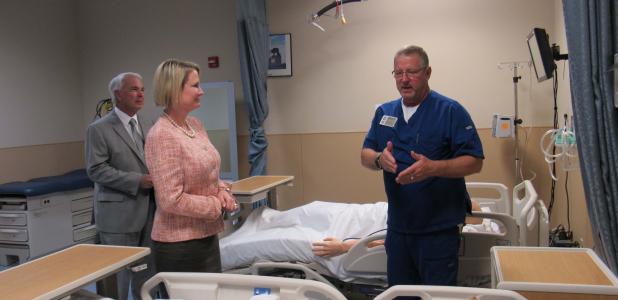Buckingham tours CTC, discusses transition program for military
By BRITTANY FHOLER
Cove Leader-Press
State Senator Dawn Buckingham visited Central Texas College and received a tour of the college’s Nursing Center with Chancellor Jim Yeonopolus Monday afternoon.
The two-story Nursing Center facility first opened for the Spring 2011 semester and contains a simulation center meant to replicate a hospital, complete with an ambulance bay, a six-bed emergency room, two six-bed medical/surgical wards, two two-bed intensive care wards, a four-bed pediatric room, a two-bed Labor and Delivery room with two warmers, an operating room and a home health room.
Yeonopolus said he wanted to show the simulation center because in the case of an emergency, it can be converted into a full-fledged hospital.
Buckingham, who represents District 24 in the Texas Senate, is familiar with medicine as a board-certified physician specializing in oculoplastic reconstructive and cosmetic surgery who also provides general ophthalmology services to her patients in Austin.
Buckingham was guided by paramedic lead instructor Julie Jordan and lab/simulation center manager Robert O’Dell, who explained the purpose of each simulation room and how the students learn from each room and from using the manikins and equipment. One example given was of how there are model limbs that students can use to learn how to deal with someone who has loss of limb, which is important especially when dealing with veterans and members of the military.
Another example was the labor and delivery simulation room, complete with a manikin that gives birth and that can be controlled by faculty to give students the opportunity to experience just about every scenario they might with a living patient. EMT students can experience dealing with a breech delivery or a prolapsed cord or shoulder dystocia.
“We do our best to be able to let our students go through that training before they ever go out into their clinical sites,” O’Dell told Buckingham.
In the main EMS classroom on the second floor, there is an ambulance simulator with a fully functioning manikin that lets students practice before they are sent out into the field.
“Doing things in a classroom in a perfect environment is one thing,” Yeonopolus said. “When you’re doing it out in the field, in the public, on the street, out of context of this, it’s a whole different scenario.”
After the tour, Buckingham said she thought the facilities and program were amazing. This was her first time touring the Nursing facility, but was one of several visits she had made to the campus.
Central Texas College is doing innovative and creative things, Buckingham said.
“I think they’re really producing excellent clinicians, starting to really have them make good habits early, they’re going to work well later so we’re just glad to be here today and impressed with what they’re doing,” Buckingham said.
Buckingham shared that the opportunities CTC provides to veterans, who make up a good population of its students, and those transitioning out of the military are important.
“One, we want to take care of our veterans and know how to take care of them,” Buckingham said. “Two, we want them to transition into the workforce as easily as possible. We passed a bill to help with that this last session.”
The bill Buckingham referred to was HB 257 which was filed in the House of Representatives by Rep. Ana Hernandez and later joint authored and coauthored by several other representatives and sponsored by Senator Buckingham, who filed an identical version in the Senate. The House bill made its way through the House committee on Defense & Veterans’ Affairs and the Senate committee on Veteran Affairs and Border Security before it was then signed by Governor Greg Abbott, becoming law effective Sept. 1, 2017.
The bill requires a report that identifies the five most common military occupational specialties of servicemembers who are transitioning from military service to employment; the five occupations for which the five MOS identified best offer transferable skills that meet the needs of employers; and any industry-based certifications that align with the five MOS. The bill is intended to help address the employment gap that many members of the military experience when transitioning into the workforce.
Yeonopolus said he always appreciates when elected officials come to see what CTC is doing, because they are the ones the college relies on to introduce legislation to bring funding that allows Central Texas College to continue moving forward.
Yeonopolus added that CTC has been working with the military for over 50 years and has been providing evaluated credit for those exiting for 50 years.
“We kind of set the bar for that evaluation process,” Yeonopolus said. “The thing that makes this transition really well is that now we can take these soldiers who are transitioning out of the service, we can actually provide them 40 hours of training up to 22 weeks, we can get them into programs like this, that might take 12 weeks or 15 week or 18 weeks to get through and compress it down based on their MOS.”
Currently, there are 25 students who just started in a program that takes Army Combat Medics (68W) and offers them a compressed program for EMT training, where they come to class one day a week for an all-day class, for nine weeks. The program would normally last 18 weeks, but because of their prior training and skills, it is compressed, Yeonopolus said.

